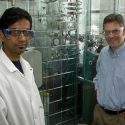Chemists find a new chink in TB’s armor
The family of bacteria that causes tuberculosis (TB) and leprosy are notoriously sturdy. And although the diseases they cause have been held in check for the past 50 years by antibiotics, some strains are becoming increasingly resistant to existing therapy.
Now, however, a new chink has been found in the cellular armor that makes these infectious diseases difficult to treat. The discovery, reported today (May 9) in the online editions of the journal Nature Structural & Molecular Biology by a team of chemists and biochemists from UW–Madison, opens the door to the development of a new family of antibiotics to treat diseases that still claim as many as 3 million lives annually worldwide.
“Most of the treatments we have for these diseases date from the 1950s,” says Laura L. Kiessling, a UW–Madison professor of chemistry and the leader of the team reporting the new discovery. “Many traditional antibiotics don’t work against tuberculosis.”
The bacteria that cause tuberculosis are literally tough as nails. With unique multilayered cell walls, the microbes resist easy treatment.
Current drug regimens typically last up to six months and require a mix of as many as six different drugs. Because the drugs cause unpleasant side effects, and because patients often feel better after a month or two, many people do not complete treatments, a phenomenon contributing to a worldwide epidemic of multidrug-resistant TB. Adding to the problem, in less developed countries where TB is most common, health care is spotty and drug supplies are frequently inadequate.
Kiessling and her colleagues, working with the support of the National Science Foundation, have detailed the workings of a key enzyme that the bacterium requires to maintain the integrity of its cell walls. Enzymes are proteins that initiate chemical reactions within plant and animal cells.
“We’ve figured out how this enzyme works. If you knock it out, the bacteria aren’t viable,” Kiessling explains. “It’s an essential enzyme.”
The TB microbe’s success and resistance to traditional drugs is attributed in large measure to its multilayered cell wall, composed of chicken wire-shaped molecules wrapped around an inner membrane. Atop that structure, are three more layers that further insulate the microbe from attack by traditional antibiotics.
The enzyme is required for the TB bacterium to build its cell wall. The enzyme, in turn, depends on a derivative of vitamin B2 to make a cell wall building block. The work published today by Kiessling’s group shows that the enzyme uses the vitamin in a new way, which also gives it a new biological role.
Detailing the interplay between vitamin B2 and the enzyme provides a blueprint for inhibitors of the enzymes that keep the bacterium’s cell walls intact. As a result, Kiessling’s group has effectively identified a target for drug manufactures interested in developing new antibiotics to combat TB and other diseases such as leprosy, which are caused by similar types of bacteria.
“Because we understand the mechanism better, we can design inhibitors of this enzyme,” Kiessling says.
However, she notes that under the best circumstances, it takes years and many millions of dollars for new drugs to be developed. What’s more, she says, many major drug manufacturers are not actively pursuing the development of new antibiotics, despite growing resistance by microbes to antibiotics currently in use.
Tuberculosis, once commonly referred to as consumption, has a long history. Evidence of tubercular decay has been found in the bones of Egyptian mummies. It was identified by Hippocrates, the ancient Greek physician, as the most widespread and fatal disease of the ancient world. It has claimed many notable victims throughout history, including the poet John Keats, composer Frederick Chopin, playwright Anton Chekhov and writers Robert Louis Stevenson, Emily Bronte, D.H. Lawrence and George Orwell.
In addition to Kiessling, the authors of the Nature Structural & Molecular Biology paper include Michelle Soltero-Higgin and Todd D. Gruber of the UW–Madison Department of Biochemistry and Erin E. Carlson of the UW–Madison Department of Chemistry.
Tags: biosciences, research



